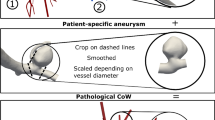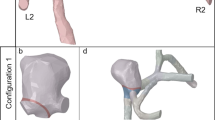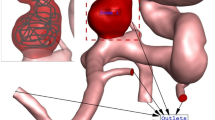Abstract
The importance of properly treating boundary conditions (BCs) in numerical simulation of hemodynamics in intracranial aneurysm (IA) has been increasingly recognized. In this study, we constructed three types of computational model for each IA to investigate how the outcome of numerical simulation is affected by the treatment of BCs. The first type of model (i.e., Type-A model) was obtained by applying 3-D hemodynamic modeling to the entire cerebral arterial network, with its solution being taken as the reference for evaluating the performance of the other two types of model (i.e., Type-B and Type-C models) in which 3-D modeling was confined to the aneurysm region. In addition, patient-specific 1-D models of the cerebral arterial network were developed to provide hemodynamic information for setting the inflow/outflow BCs of the 3-D models. Numerical tests on three IAs revealed that prescribing the outflow BCs of a localized 3-D aneurysm model based on 1-D model-simulated outflow division (i.e., Type-B model) instead of imposing the free outflow BC on all outlets (i.e., Type-C model) helped to improve the fidelity of the simulation of intra-aneurysmal hemodynamics, but could not guarantee a complete reproduction of the reference solution obtained by the Type-A model. Moreover, it was found that the outcome of hemodynamic simulation was more sensitive to the treatment of BCs when an aneurysm was located at arterial bifurcation rather than sidewall. These findings highlight the importance of taking into account systemic cerebroarterial hemodynamics in computational modeling of hemodynamics in IAs, especially those located at bifurcations.
Similar content being viewed by others
References
Bijlenga P., Ebeling C., Jaegersberg M. et al. Risk of rupture of small anterior communicating artery aneurysms is similar to posterior circulation aneurysms [J]. Stroke, 2013, 44(11):3018–3026.
Molyneux A. J., Kerr R. S., Yu L. M. et al. International subarachnoid aneurysm trial (ISAT) of neurosurgical clipping versus endovascular coiling in 2143 patients with ruptured intracranial aneurysms: a randomised comparison of effects on survival, dependency, seizures, rebleeding, subgroups, and aneurysm occlusion [J]. The Lancet, 2005, 366(9488): 809–817.
Vlak M. H., Algra A., Brandenburg R. et al. Prevalence of unruptured intracranial aneurysms, with emphasis on sex, age, comorbidity, country, and time period: a systematic review and meta-analysis [J]. The Lancet Neurology, 2011, 10: 626–636.
Juvela S., Porras M., Poussa K. Natural history of unruptured intracranial aneurysms: probability of and risk factors for aneurysm rupture [J]. Journal of Neurosurgery, 2000, 93(3): 379–387.
Claiborne J.S., Wilson C. B., Halbach V. V. et al. Endovascular and surgical treatment of unruptured cerebral aneurysms: comparison of risks [J]. Annals of Neurology, 2000, 48(1): 11–19.
Brown Jr. R. D., Broderick J. P. Unruptured intracranial aneurysms: epidemiology, natural history, management options, and familial screening [J]. The Lancet Neurology, 2014, 13(4): 393–404.
Wiebers, D. O. International study of unruptured intracranial aneurysms investigator. Unruptured intracranial aneurysms: natural history, clinical outcome, and risks of surgical and endovascular treatment [J]. The Lancet, 2003, 362: 103–110.
Lindner S. H., Bor A. S., Rinkel G. J. Differences in risk factors according to the site of intracranial aneurysms [J]. Journal of Neurology, Neurosurgery & Psychiatry, 2010, 81(1): 116–118.
Cebral J. R., Raschi M. Suggested connections between risk factors of intracranial aneurysms: a review [J]. Annals of Biomedical Engineering, 2013, 41(7): 1366–1383.
Juvela S., Poussa K., Lehto H. et al. Natural history of unruptured intracranial aneurysms: a long-term follow-up study [J]. Stroke, 2013, 44(9): 2414–2421.
Chong W., Zhang Y., Qian Y. et al. Computational hemodynamics analysis of intracranial aneurysms treated with flow diverters: correlation with clinical outcomes [J]. American Journal of Neuroradiology, 2014, 35(1): 136–142.
Mut F., Ruijters D., Babic D. et al. Effects of changing physiologic conditions on the in vivo quantification of hemodynamic variables in cerebral aneurysms treated with flow diverting devices [J]. International Journal for Numerical Methods in Biomedical Engineering, 2014, 30(1): 135–142.
Xiang J., Tutino V. M., Snyder K. V. et al. CFD: computational fluid dynamics or confounding factor dissemination? The role of hemodynamics in intracranial aneurysm rupture risk assessment [J]. American Journal of Neuroradiology, 2014, 35(10): 1849–1857.
Chung B., Cebral J. R. CFD for evaluation and treatment planning of aneurysms: review of proposed clinical uses and their challenges [J]. Annals of Biomedical Engineering, 2015, 43(1):122–138.
Oshima M., Torii R., Tokuda S. et al. Patient-specific modeling and multi-scale blood simulation for computational hemodynamic study on the human cerebrovascular system [J]. Current Pharmaceutical Biotechnology, 2012, 13(11): 2153–2165.
Chen J. L., Wang S. Z., Ding G. H. et al. Patient-specific blood dynamic simulations in assessing endovascular occlusion of intracranial aneurysms [J]. Journal of Hydrodynamics, 2009, 21(2): 271–276.
Wang S. Z., Chen J. L., Ding G. H. Non-newtonian computational hemodynamics in two patient-specific cerebral aneurysms with daughter saccules [J]. Journal of Hydrodynamics, 2010, 22(5): 639–646.
Qiu X. N., Fei Z. M., Zhang J. et al. Influence of high-porosity mesh stent on hemodynamics of intracranial aneurysm: A computational study [J]. Journal of Hydrodynamics, 2013, 25(6): 848–855.
Han X., Liu X. S., Liang F. Y. The influence of outflow boundary conditions on blood flow patterns in an AcoA aneurysm [J] Chinese Journal of Hydrodynamics, 2015, 30(6): 692–700(in Chinese).
Tsang A. C. O., Yiu B. Y. S., Tang A. Y. S. et al. The effect of downstream resistance on flow diverter treatment of a cerebral aneurysm at a bifurcation: A joint computational-experimental study [J]. Journal of Hydrodynamics, 2018, 30(5): 803–814.
Xiang J., Natarajan S. K., Tremmel, M. et al. Hemodynamic–morphologic discriminants for intracranial aneurysm rupture [J]. Stroke, 2011, 42:144–152.
Xiang J., Yu J., Snyder K. V. et al. Hemodynamic–morphological discriminant models for intracranial aneurysm rupture remain stable with increasing sample size [J]. Journal of Neurointerventional Surgery, 2014, 8: 104–110.
Cebral J. R., Mut F., Weir J. et al. Quantitative characterization of the hemodynamic environment in ruptured and unruptured brain aneurysms [J]. American Journal of Neuroradiology, 2011,32: 145–151.
Takao H., Murayama, Y., Otsuka S. et al. Hemodynamic differences between unruptured and ruptured intracranial aneurysms during observation [J]. Stroke, 2012, 43: 1436–1439.
Schnell S., Wu C., Ansari S. A. 4D MRI flow examinations in cerebral and extracerebral vessels. Ready for clinical routine? [J]. Current Opinion in Neurology, 2016, 29(4): 419.
Krabbe-Hartkamp M. J., Van der Grond J., De Leeuw F. E. et al. Circle of Willis: morphologic variation on three-dimensional time-of-flight MR angiograms [J]. Radiology, 1998, 207(1): 103–111.
Hendrikse J., van Raamt A. F., van der Graaf Y. et al. Distribution of cerebral blood flow in the circle of Willis [J]. Radiology, 2005, 235(1): 184–189.
Alastruey J., Parker K.H., Peiro J. et al. Modelling the circle of Willis to assess the effects of anatomical variations and occlusions on cerebral flows [J]. Journal of Biomechanics, 2007, 40(8): 1794–1805.
Liang F. Y., Fukasaku K., Liu H. et al. A computational model study of the influence of the anatomy of the circle of Willis on cerebral hyperperfusion following carotid artery surgery [J]. Biomedical Engineering Online, 2011, 10(84): 1–22.
Mu L. Z., He Y., Chen J. Y. et al. Study of blood flow regulation in a patient-specific model for the circle of Willis with an aneurysm by computational and in-vitro simulation [J]. Chinese Journal of Hydrodynamics, 2015, 30(6): 707–715(in Chinese).
Huang P. G., Muller L. O. Simulation of one-dimensional blood flow in networks of human vessels using a novel TVD scheme [J]. International Journal for Numerical Methods in Biomedical Engineering, 2015, 31(5): e02701.
Zhang H., Fujiwara N., Kobayashi M. et al. Development of a numerical method for patient-specific cerebral circulation using 1d–0d simulation of the entire cardiovascular system with SPECT data [J]. Annals of Biomedical Engineering, 2016, 44(8): 2351–2363.
Formaggia L., Lamponi D., Quarteroni A. One-dimensional models for blood flow in arteries [J]. Journal of Engineering Mathematics, 2003, 47(3-4): 251–276.
Liang F. Y., Takagi S., Himeno R. et al. Multi-scale modeling of the human cardiovascular system with applications to aortic valvular and arterial stenoses [J]. Medical & Biological Engineering & Computing, 2009, 47(7): 743–755.
Moore S., David T., Chase J. G. et al. 3D models of blood flow in the cerebral vasculature [J]. Journal of Biomechanics, 2006, 39(8): 1454–1463.
Ghaffari M., Tangen K., Alaraj A. et al. Large-scale subject-specific cerebral arterial tree modeling using automated parametric mesh generation for blood flow simulation [J]. Computers in Biology and Medicine, 2017, 91: 353–365.
Marzo A., Singh P., Larrabide I. et al. Computational hemodynamics in cerebral aneurysms: the effects of modeled versus measured boundary conditions [J]. Annals of Biomedical Engineering, 2011, 39(2): 884–896.
Liang F. Y., Oshima M., Huang H. et al. Numerical study of cerebroarterial hemodynamic changes following carotid artery operation: a comparison between multiscale modeling and stand-alone three-dimensional modeling [J]. Journal of Biomechanical Engineering, 2015, 137(10): 101011.
Dobroserdova T. K., Olshanskii M. A. A finite element solver and energy stable coupling for 3D and 1D fluid models [J]. Computer Methods in Applied Mechanics and Engineering, 2013, 259: 166–176.
Blanco P. J., Feijóo R. A. A dimensionally-heterogeneous closed-loop model for the cardiovascular system and its applications [J]. Medical Engineering & Physics, 2013,35(5): 652–667.
Formaggia L., Quarteroni A., Vergara C. On the physical consistency between three-dimensional and one-dimensional models in haemodynamics [J]. Journal of Computational Physics, 2013, 244: 97–112.
Xu L., Liang F., Gu L. et al. Flow instability detected in ruptured versus unruptured cerebral aneurysms at the internal carotid artery[J]. Journal of Biomechanics, 2018, 72: 187–199.
Xu L., Liang F., Zhao B. et al. Influence of aging-induced flow waveform variation on hemodynamics in aneurysms present at the internal carotid artery: A computational model-based study [J]. Computers in Biology and Medicine, 2018, 101: 51–60.
Grinberg L., Cheever E., Anor T. et al. Modeling blood flow circulation in intracranial arterial networks: a comparative 3D/1D simulation study [J]. Annals of Biomedical Engineering, 2011, 39(1): 297–309.
Liang F. Y., Takagi S., Himeno R. et al. Biomechanical characterization of ventricular–arterial coupling during aging: A multi-scale model study [J]. Journal of biomechanics, 2009, 42(6): 692–704.
Vassilevski Y. V., Salamatova V. Y., Simakov S. S. On the elasticity of blood vessels in one-dimensional problems of hemodynamics [J]. Computational Mathematics and Mathematical Physics, 2015, 55(9): 1567–1578.
Reymond P., Merenda F., Perren F. et al. Validation of a one-dimensional model of the systemic arterial tree [J]. American Journal of Physiology-Heart and Circulatory Physiology, 2009, 297(1): H208–H222.
Yu H., Huang G. P., Yang Z. et al. The influence of normal and early vascular aging on hemodynamic characteristics in cardio-and cerebrovascular systems [J]. Journal of Biomechanical Engineering, 2016, 138(6): 061002.
He Y., Liu H., Himeno R. A one-dimensional thermo-fluid model of blood circulation in the human upper limb [J]. International Journal of Heat and Mass Transfer, 2004, 47(12-13): 2735–2745.
Liang F., Liu X., Yamaguchi R. et al. Sensitivity of flow patterns in aneurysms on the anterior communicating artery to anatomic variations of the cerebral arterial network [J]. Journal of Biomechanics, 2016, 49(15): 3731–3740.
Jansen I. G., Schneiders J. J., Potters W. V. et al. Generalized versus patient-specific inflow boundary conditions in computational fluid dynamics simulations of cerebral aneurysmal hemodynamics [J]. AJNR American Journal of Neuroradiology, 2014, 35: 1543–1548
Appanaboyina S, Mut F., Löhner R. et al. Computational modelling of blood flow in side arterial branches after stenting of cerebral aneurysms [J]. International Journal of Computational Fluid Dynamics, 2008, 22(10): 669–676.
Chnafa C., Brina O., Pereira V. M. et al. Better than nothing: A rational approach for minimizing the impact of outflow strategy on cerebrovascular simulations [J]. American Journal of Neuroradiology, 2018, 39(2):337–343..
Bammer R., Hope T. A., Aksoy M. et al. Time-resolved 3D quantitative flow MRI of the major intracranial vessels: initial experience and comparative evaluation at 1.5 T and 3.0 T in combination with parallel imaging [J]. Magnetic Resonance in Medicine, 2007, 57(1): 127–140.
Umeda Y., Ishida F., Hamada K. et al. Novel dynamic four-dimensional CT angiography revealing 2-type motions of cerebral arteries [J]. Stroke, 2011, 42: 815–818.
Torii R., Oshima M., Kobayashi T. et al. Influence of wall elasticity in patient-specific hemodynamic simulations [J]. Computers & Fluids, 2007, 36: 160–168.
Bazilevs Y., Hsu M. C., Zhang Y. et al. A fully-coupled fluid-structure interaction simulation of cerebral aneurysms [J]. Computational Mechanics, 2010, 46: 3–16.
Acknowledgments
This work was supported by the Clinical Research Plan of SHDC (Grant Nos. 16CR3031A, 16CR2045B), the SJTU Medical-Engineering Crosscutting Research Foundation (Grant Nos. YG2015MS53, YG2017MS45).
Author information
Authors and Affiliations
Corresponding author
Additional information
Biography: Zhi-qiang Zhang (1993-), Male, Master Candidate
Rights and permissions
About this article
Cite this article
Zhang, Zq., Xu, Lj., Liu, R. et al. Importance of incorporating systemic cerebroarterial hemodynamics into computational modeling of blood flow in intracranial aneurysm. J Hydrodyn 32, 510–522 (2020). https://doi.org/10.1007/s42241-019-0038-9
Received:
Revised:
Accepted:
Published:
Issue Date:
DOI: https://doi.org/10.1007/s42241-019-0038-9




